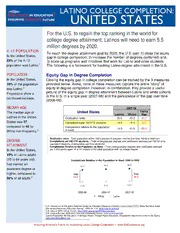
ERIC ED532060: Latino College Completion: United States PDF
Preview ERIC ED532060: Latino College Completion: United States
LATINO COLLEGE COMPLETION: UNITED STATES For the U.S. to regain the top ranking in the world for college degree attainment, Latinos will need to earn 5.5 million degrees by 2020. K-12 POPULATION To reach the degree attainment goal by 2020, the U.S. can: 1) close the equity In the United States, gap in college completion; 2) increase the number of degrees conferred; and, 22% of the K-12 3) scale up programs and initiatives that work for Latino and other students. population was Latino.1 The following is a framework for tracking Latino degree attainment in the U.S. POPULATION E quity Gap in Degree Completion In the United States, C losing the equity gap in college completion can be tracked by the 3 measures 16% of the population p rovided below. Alone, none of these measures capture the entire “story” of was Latino.2 equity in degree completion. However, in combination, they provide a useful picture of the equity gap in degree attainment between Latino and white cohorts Projections show a in the U.S. in a single year (2007-08) and the persistence of the gap over time continued increase. (2006-08). MEDIAN AGE 2007-08 The median age of United States Equity Latinos Whites Gap Latinos in the United Graduation rates 35.6 49.3 13.7 States was 27, Completions per 100 FTE students 14.8 18.5 3.7 compared to 40 for Completions relative to the population 14.9 40.9 26.0 White non-Hispanics.3 in need Graduation rates - Total graduation within 150% percent of program time for first-time, full-time freshman DEGREE Completions per 100 FTE students – Total undergraduate degrees and certificates awarded per 100 full-time ATTAINMENT equivalent students (incorporates part-time students) Completions Relative to the Population in Need – Total undergraduate degrees and certificates awarded In the United States, per 1,000 adults aged 18 to 44 relative to the adult population with no college degree 19% of Latino adults (25 to 64 years old) Completions Relative to the Population in Need: 2006 to 2008 had earned an 38.2 39.7 40.9 associate degree or higher, compared to Gap: Gap: 38% of all adults.4 24.8 26.0 13.4 14.2 14.9 2005-06 2006-07 2007-08 White Latino 1 U.S. Department of Education, National Center for Education Statistics, Common Core of Data (CCD), "State Nonfiscal Public Elementary/Secondary Education Survey", 2009-10, v.1b. www.nces.ed.gov/ccd 2 U.S. Census 2010: United States. http://2010.census.gov/2010census/data/ 3 U.S. Census Bureau, 2006-2010 American Community Survey. www.census.gov/acs 4 Lumina Foundation for Education. A Stronger Nation Through Higher Education. Educational Attainment Levels for the States. www.luminafoundation.org Ensuring America’s Future by Increasing Latino College Completion • www.EdExcelencia.org Degrees Conferred Another metric to benchmark college completion is to track the progress of total degrees awarded over time. This measure may be the result of an increase in overall enrollment numbers rather than an increase in rates of completion. From 2005-06 to 2007-08, • the number of Hispanics who earned an undergraduate degree in the U.S. increased about 12% from 2006-08, while all other race/ethnic groups increased 5%. • the U.S. increased degrees conferred to Latinos over 3 years. For more information on these metrics, download Benchmarking Latino College Completion to Meet National Goals: 2010 to 2020 and Degrees Conferred to Latinos: 2006-2008 at www.EdExcelencia.org/research/EAF/Benchmarking Examples of What Works for Latino Students There are institutions showing success in enrolling, retaining, and graduating Latino students. The following are examples of institutional programs across the country with evidence of effectiveness in serving Latino students nominated for Examples of Excelencia. Puente Project – The University of California The mission of the Puente Project is to increase the number of educationally disadvantaged students who enroll in four-year colleges and universities, earn college degrees, and return to the community as mentors and leaders of future generations. To accomplish this, counselors, teachers and mentors work together to provide students with the necessary tools to successfully transfer to four-year institutions. Through the Puente Project, Latino students persist at greater rates than other students (83% vs. 68%), transfer to four-year institutions at higher rates than other students (52% vs. 39%), and graduate at similar rates to White students (86% vs. 84%). (http://www.puente.net/) Achieving a College Education (ACE) Program - Maricopa County Community College District The Maricopa Achieving a College Education (ACE) Program is a collaboration of area universities, high schools, “at risk” students, and their parents. The ACE cycle takes two years and integrates nine essential elements. The goal is to increase the number of students graduating from high school, increase the number of students continuing on to college, and increase the number of students earning a degree or certificate. From its inception ACE has served 6,133 students. In 2002, 88-96% of participants had graduated from high school, and 83% of ACE graduates enrolled in college. The average ACE college grade point average (GPA) is 3.1 vs. 2.81 for the general student population. (http://www.maricopa.edu/studentaffairs/ACE.php). For more information on institutional programs improving Latino student success in higher education, access Excelencia in Education’s Growing What Works database at http://www.edexcelencia.org/examples Ensuring America’s Future partners in the U.S.: Ensuring America's Future by Increasing Latino College Completion (EAF) is an Excelencia in Education initiative in collaboration with 65 national partners from 7 diverse sectors, including business/workforce, education associations and education policy, government/elected officials, institutions of higher education/systems, Latino advocacy, media and philanthropy. Together, the coalition works to inform, engage and sustain efforts to promote the role of Latinos in making the United States the world leader in college degree completion. Ensuring America’s Future by Increasing Latino College Completion • www.EdExcelencia.org
